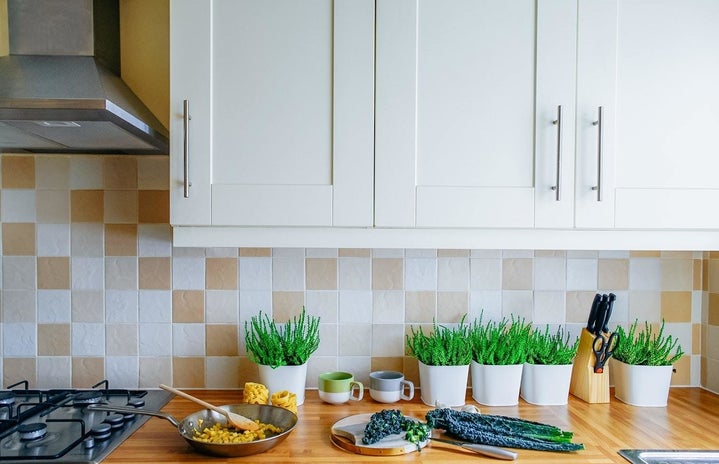To really be thriving as an independent, savvy adult, you need to exercise a certain degree of choice when it comes to food. Not that every day is perfectly balanced or top-tier, but your diet should revolve around basic food pyramid principles and take into consideration your specific needs based on caloric intake, nutritional requirements, and of course, what makes you feel good! Disclaimer: I’m not a nutritionist! What I do know how is to eat well under the constraints of a small budget, coming from a full-time college student and hungry athlete. Here are the basics of putting together a meal plan for one week:
Breakfast
In the morning, time is of the essence. For simple breakfasts, a probiotic yogurt, fiber-filled cereal or toasted bread are usually my first picks for on-the-go. To up the ante, top with fresh fruit like strawberries, blueberries, pomegranate seeds or banana slices. You can also add nuts, coconut or chia/flax seeds for a little extra ~oomph~. Make sure your favorite fruit is kept on-hand for snacks and if it’s too much work to slice up in the morning, do it the night before and place in an airtight container in your fridge. Personal favorites include (1) a toasted bagel topped with cream cheese, spinach leaves, and strawberry or apple slices, (2) pan-fried onion and sweet potato — two potatoes can cover four meals — with an over easy egg and avocado slices and (3) two overripe bananas smashed and mixed with raw oats and cinnamon. Be sure to add a fruit juice, milk (chocolate is my go-to) or nut milk to get in extra vitamins or protein. Take these with you like you would coffee if in a rush.
Quick tip: extra carbs from dinner like rice, diced potatoes, or hearty grains can be used as a base for breakfast! Add diced onions or other seasonings like garlic, green onions, and salt and pepper, then saute in a pan with olive oil. An egg on top or other protein like beans, ham, boiled chicken (can be done the night before) or tofu makes this a full breakfast!
Lunch
A flexible and lighter meal in the day, lunch has more room for experimental combinations, depending on your picks for protein and veggies. A sandwich is easy and can be switched up by toasting or varying condiments and greens (spinach or a spicier choice like arugula). This is especially helpful if you happen to have one or two staple meats, like boiled chicken breasts or sliced turkey you bought at the store. With more time ahead of your meal, try grain bowls with quinoa, barley or brown rice with fresh veggies and protein of your choice. Add a flavorful dressing like pesto, vinaigrette, balsamic, or sriracha. Fruit like berries or fresh citrus can change a grain bowl into a salad, with a different dressing and greens. A pasta with parmesan, pesto, and cherry tomato halves or a store bought sauce can be packed with snacks to simplify meal planning. As always, remember to stay hydrated and carry a reusable water bottle to be sustainable! Water is entirely underrated and keeps hunger at bay.
Quick tip: pack crunchy salad toppings and dressing separately, in a tightly-sealed container, to prevent spillage or soggy greens. Also, make use of free condiments at dining establishments and even more important any veggies or grains you can muster from the salad bar.
Dinner
For dinner, please do the world a favor and upgrade your ramen. Here’s how: use store-bought vegetables or chicken broth instead of the packet, add julienned carrots, grated ginger (very inexpensive, flavorful, and lasts in the fridge), green onion and garlic. Soup is a great go-to because it can be made on a weekend and last for a few days. Choose a broth, a protein, a grain (pasta, potato, quinoa, etc.) and then add all the veggies you can afford. Beans usually make for excellent soup because they thicken the broth and diced onion is, to me, a necessity. Any ingredients you over-estimated quantities for should be used in another meal to not create any food waste. If not a soup, try a stir-fry. The principles are the same, and vegetables can be chopped ahead of time and stored in the fridge for a couple of days. Key ingredients are rice or noodles, protein, soy sauce, ginger, garlic and some “good for you veggies”, like broccoli, mushrooms and carrots. Work within your budget and optimize veggies intake by buying canned if necessary. The cheapest veggies in the grocery aisle are usually just the same as the more expensive.
Quick tip: use everything! Most ingredients can be entirely consumed if you Google how to do it. This also saves your budget and leads to new flavor combos!
Snacks
Fresh or dried fruit, cheese and hummus with veggies top my list for snacks. All of these can be prepped before your busy day of class and eaten without much disruption. Pretzels and nuts are good to mix in because they have less sodium than typical chips and leave you feeling fuller longer. Cheap veggies that last long and can be bought in bulk on a small budget are celery stalks and carrots. Boiled eggs are convenient because they take ten minutes the night before and a batch of three to five can be incorporated into other meals.
The secret to meal planning is to narrow down your favorite ingredients and allow them to work for you in their versatility. Most proteins like chicken, egg or tofu can be prepped, cooked or marinated overnight, then sliced for topping or tossing last minute. Most vegetables can be chopped at the night before and added to dishes or snacked on by themselves. In my personal experience, fruit can be trickier due to air exposure, but berries are a reliable choice for simple prep and bananas are easily the most versatile for meal options. While budget usually takes priority, don’t forget to mix it up and expand your options to keep meal prep exciting. Most importantly, eat what makes your body happy and take pride in the little containers you fill with balanced and healthy meals.



